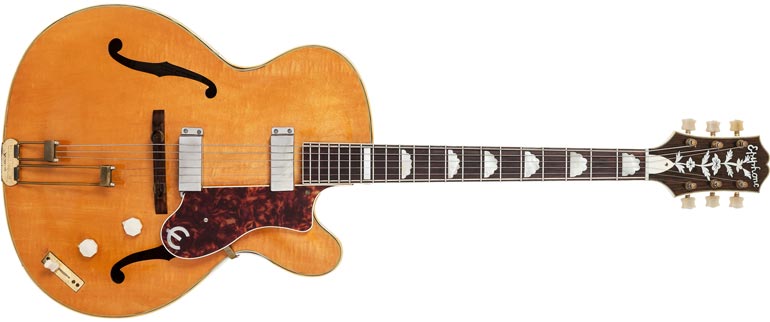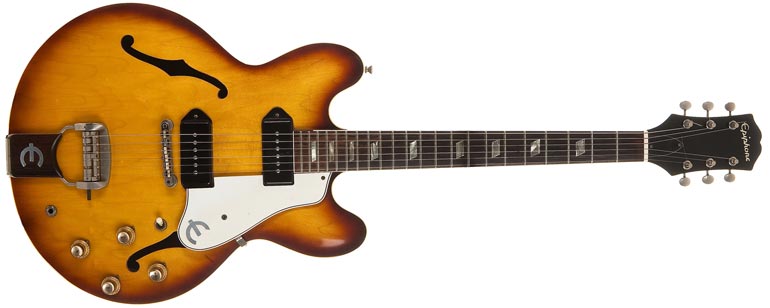
 Image Heritage auctions
Image Heritage auctions
Under the ownership of the Stathopoulos family, Epiphone had a long history of producing acoustic and carved top guitars, and mandolins, and developed pickups for lap steel guitars as early as 1935. Epiphone electric Spanish guitars, however, were still some years away. In the early 1950s, Epiphone finally produced a number of full-bodied electric acoustics; very fine guitars such as the three pickup Emperor, two pickup Deluxe Electric (above), and the various versions of the Zephyr and Century. These were very nice guitars, and, in fact, the only electric guitars produced by Epiphone prior to the brand being taken over by Gibson in 1957.
These early hollow body guitars were beautifully-built, high quality instruments with fine appointments. They were fitted with Epiphone's 'New York' single coil units. These large body hollow body guitars had a great reputation amongst jazz and big band guitarists. Vintage Epiphone guitars from this pre-Gibson period are highly collectable instruments, and having only been produced in small numbers command quite high prices today. With the untimely death of Epaminondas Stathopoulos, the company lost it's direction, first relocating from New York to Philadelphia, and ultimately being absorbed by it's main competitor, Gibson. Many of the original Epiphone luthiers actually went on to work for the newly emerging Guild guitar company.
When Gibson took on the Epiphone marque, they brought production from Philadelphia to their Kalamazoo plant in Michigan. They inherited all tooling, partially finished instruments and components, allowing them to continue Epiphone production. Over the next few years, Gibson relaunched many of these models, and added several more; keeping original names, and selected design features and hardware from pre-Gibson days, but the majority were given a new thinner body, in keeping with the popular Electric Spanish series guitars just launched by Gibson (ES-330, ES-335 etc).
Only one pre-Gibson model, the Epiphone Broadway kept it's original full body depth, but it was joined in 1964 by a new model, a signature guitar for jazz guitarist Howard Roberts, and then a second model the Howard Roberts Custom in 1965. Both were eventually branded Gibson (see the Gibson Howard Roberts) once Epiphone production left Kalamazoo at the end of the 1960s.
 Image Heritage auctions
Image Heritage auctions
Guitars like the Riviera and Sheraton built reputations for themselves, but none more-so than the Casino which was favoured by, amongst others, the Beatles and the Rolling Stones. This was Kalamazoo-built Epiphone's best selling hollow-body, with almost 7000 guitars shipped throughout the 1960s. In terms of quality and functionality, these US Kalamazoo-built Epiphones were on par with Gibson's own output, and typically retailed at the same pricepoint.
Market pressures in the late 1960s were forcing US manufacturers to offer lower priced guitars, able to compete with Asian imports. Epiphone production continued at Kalamazoo until 1969, but the decision was finally made to realign the brand below the US-built Gibsons. This coincided with a change of ownership of Gibson - the 'Norlin period'. Production of a new line of Epiphones was awarded to Aria, who produced a new electric acoustic model at the Matsumoku plant in Japan. Epiphone model 5102T was the only semi-acoustic guitar in the line at this time, morphing into the EA250 by 1972. These models were very basic, with a bolt-on neck; a world away from the quality American guitars bearing the marque in the 1960s.
But as the seventies progressed, Matsumoku production improved. By the mid 1970s, they were able to offer set neck reissues of the older models - however at a price point that confined them to the Japanese market. Finally in 1982, the Casino, Emperor, Riviera and Sheraton were again offered in the United States, and interestingly enough, a full body depth version of the Epiphone Emperor was available again for the first time since the mid-1950s.
Asian Epiphone production has continued since this time, though moving from Japan to Korea and China. Although not in the same league as the 1950s Stathopoulos-era, or the 1960s Kalamazoo-era guitars, modern day production techniques allow the offering of consistently good quality Epiphone electric acoustics, that sell very well today.
$4400
$3750
$10000
$1795
$4895
$8695
$2495
$2275